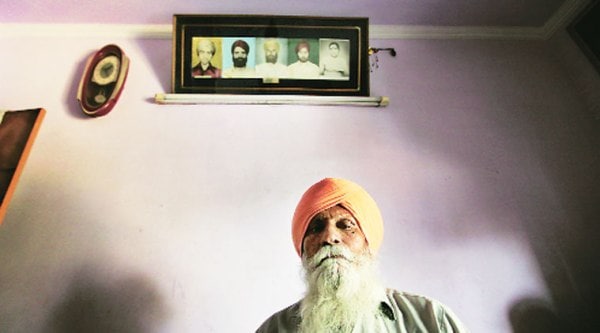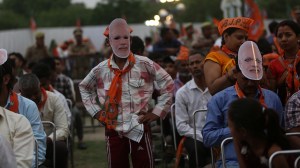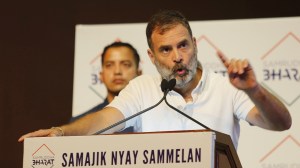- India
- International
Sikh riots: Panel after panel said police helped mob, no one heard
One of the nine committees, headed by R K Ahuja put the count of the dead in the Capital at 2,733.
 Mansa Singh’s three sons were among five of the family killed in the 1984 riots.
Mansa Singh’s three sons were among five of the family killed in the 1984 riots.
A common thread runs through the reports of nine committees, and several rights groups and NGOs, which probed the 1984 riots — all point to police lapses, at times connivance, lack of an institutional response and the dubious role of local Congress leaders in targeted attacks on Sikhs across Delhi.
One of the nine committees, headed by R K Ahuja who was a Secretary in the Ministry of Home Affairs, was tasked to find out the total number of Sikhs killed in Delhi during the riots. The Ahuja committee put the count of the dead in the Capital at 2,733.
Another probe committee, headed by Additional Commissioner of Police Ved Marwah, was asked to probe the role of the police during the carnage. Accused officers moved court and Marwah was told by the Home Ministry in 1985 to wind up the probe.
The Nanavati commission, appointed in 2000 after dissatisfaction over the findings of earlier probes, highlighted the role of the police, local Congress leaders and “the backing and help of influential and resourceful persons” during the riots. This is what it concluded:
“The attacks were made in a systematic manner and without much fear of the police; almost suggesting that they were assured that they would not be harmed while committing those acts and even thereafter. Male members of the Sikh community were taken out of their houses. They were beaten first and then burnt alive in a systematic manner. In some cases, tyres were put around their necks and then they were set on fire by pouring kerosene or petrol over them. In some cases, white inflammable powder was thrown on them which immediately caught fire thereafter. This was a common pattern which was followed by the big mobs which had played havoc in certain areas. The shops were identified, looted and then burnt. Thus, what had initially started as an angry outburst became an organized carnage.”
“…Large number of affidavits indicate that local Congress(I) leaders and workers had either incited or helped the mobs in attacking the Sikhs. But for the backing and help of influential and resourceful persons, killing of Sikhs so swiftly and in large numbers could not have happened. In many places, the riotous mobs consisted of outsiders… Outsiders in large numbers could not have been brought by ordinary persons from the public. Bringing them from outside required an organized effort. Supplying them with weapons and inflammable material also required an organized effort. There is evidence to show that outsiders were shown the houses of the Sikhs. Obviously it would have been difficult for them to find out the houses and shops of Sikhs so quickly and easily.”

“…There is enough material on record to show that at many places the police had taken away their (Sikhs) arms or other articles with which they could have defended themselves against the attacks by mobs. After they were persuaded to go inside their houses on assurances that they would be well protected, attacks on them had started. All this could not have happened if it was merely a spontaneous reaction of the angry public. The systematic manner in which the Sikhs were thus killed indicate that the attacks on them were organized.”
“…Lack of the fear of the police force was also one of the causes for the happening of so many incidents within those 3 or 4 days. If the police had taken prompt and affective steps, very probably so many lives would not have been lost and so many properties would not have been looted, destroyed or burnt.”
“… There is absolutely no evidence suggesting that Shri Rajiv Gandhi or any other high ranking Congress(I) leader had suggested or organized attacks on Sikhs. Whatever acts were done, were done by the local Congress(I) leaders and workers, and they appear to have done so for their personal political reasons. They do not appear to have done so purely for personal reasons. If they were the acts of individuals only, then the killing of Sikhs and looting of properties of Sikhs would not have been on such a large scale. Therefore, what those local leaders appear to have done is to take the help of their followers and supporters in inciting or committing those acts.”
Yet the Nanavati commission said it is “not in a position to recommend any action against them except to the extent indicated earlier while assessing the evidence against them”.
On the role of the police, this is what it said: “…Commission agrees with the findings recorded earlier by Justice Misra Commission and by the committees which had looked into their conduct. The Commission has nothing further to add and, therefore, does not think it necessary to burden this report by referring to the evidence and instances which go to show that either they were negligent in performance of their duties or that they had directly or indirectly helped the mobs in their violent attacks on the Sikhs. As appropriate actions were initiated against them, the Commission has thought it fit not to recommend any further action against them.”
“However, the Commission would like to emphasise that as a result of not recording separate FIRs, not recording statements of witnesses as stated by them and not investigating the cases properly, it has now become difficult for the Commission to make any recommendation against many of the persons who have been named by the witnesses as the persons who had indulged in violent acts against them or their family members or had facilitated the same.”
BOX 1: 147 cops indicted, no action against half
The Kusum Lata Mittal committee and Jain Aggarwal committee indicted 147 police officers for lapses during the riots. No departmental action could be taken against 42 because they had died or retired.
Of the remaining 105, the Home Ministry processed cases of eight officers. It exonerated five and penalised Additional Commissioner of Police H C Jatav with 30% cut in pension for five years. According to Nanavati commission, the inquiry against DCP Chandra Prakash was completed but the final order could not be served because of a restraint order, and the inquiry against DCP Sewa Dass was delayed till 1998 because of a stay order.
The Delhi government processed the cases of the remaining 97. No action could be taken against 29 because they had died, retired or action was time-barred. No action was initiated against 9 since inquiries were already on. The Delhi government also instituted 25 criminal cases against some of the 72 police officers.
BOX 2: Nanavati let off Bhagat, said probe Sajjan, Tytler roles
Not recommending “further action” against Congress leader H K L Bhagat “in view of his physical and mental condition”, the Nanavati commission wanted the government to probe the roles of his colleagues Sajjan Kumar and Jagdish Tytler. This is what its report said:
* Jagdish Tytler: “Commission considers it safe to record a finding that there is credible evidence against Shri Jagdish Tytler to the effect that very probably he had a hand in organizing attacks on Sikhs.”
* Sajjan Kumar: “Commission is inclined to take the view that there is credible material against Shri Sajjan Kumar and Shri Balwan Khokhar for recording a finding that he and Shri Balwan Khokhar were probably involved as alleged by the witnesses.”
BOX 3: Ten probe panels
* Marwah Commission: In November 1984, Additional Commissioner of Police Ved Marwah was asked to probe the role of the police during the riots. In 1985, he was told to wind up the probe.
* Misra Commission: In May 1985, a committee headed by Justice Ranganath Misra was appointed. In his report a year later, he said the terms of reference did not allow him to identify any individual. He asked for formation of three committees.
* Kapoor Mittal Committee: In February 1987, Justice (retired) Dilip Kapoor and Kusum Lata Mittal, a retired Secretary, were asked to probe the conduct of Delhi Police. The committee indicted 72 police officers.
* Jain Banerji Committee: A committee under Justice (retired) M L Jain and E N Renision, a retired IPS officer, was asked to examine riot cases. Renision was replaced by A K Banerji, another retired IPS officer. They could not make any progress because of an interim injunction granted by Delhi High Court. Later, the notification appointing the committee was quashed.
* Poti Rosha Committee: In March 1990, a committee comprising Justice (retired) P Subramanian Poti and retired IPS officer P A Rosha was asked to examine “cases of omission to register or properly investigate offences”. It was reconstituted after Rosha opted out and another retired IPS officer Aggarwal was brought in. Poti and Aggarwal relinquished office in September 1990.
* Jain Aggarwal Committee: Justice (retired) J D Jain and D K Aggarwal, who began their probe in December 1990, took into consideration 669 affidavits filed before the Misra Commission. It also received 415 affidavits from affected people. The committee found that in most cases, investigation carried out by the police was “absolutely casual, perfunctory and faulty”.
* Ahuja Committee: R K Ahuja, a Secretary in the Ministry of Home Affairs, was told to find out the total number of Sikhs killed in Delhi. He put that number at 2,733.
* Dhillon Committee: A committee under G S Dhillon was asked in 1985 to recommend measures for rehabilitation of the riot victims.
* Narula Committee: In 1993, the BJP government in Delhi asked it to recommend measures for Central sanction to prosecute the guilty.
* The Nanavati Commission: In 2000, Justice (retired) G T Nanavati was asked to probe the cause of the riots, the sequence of events and “recommend measures which may be adopted to meet the ends of justice”.
Apr 25: Latest News
- 01
- 02
- 03
- 04
- 05







































